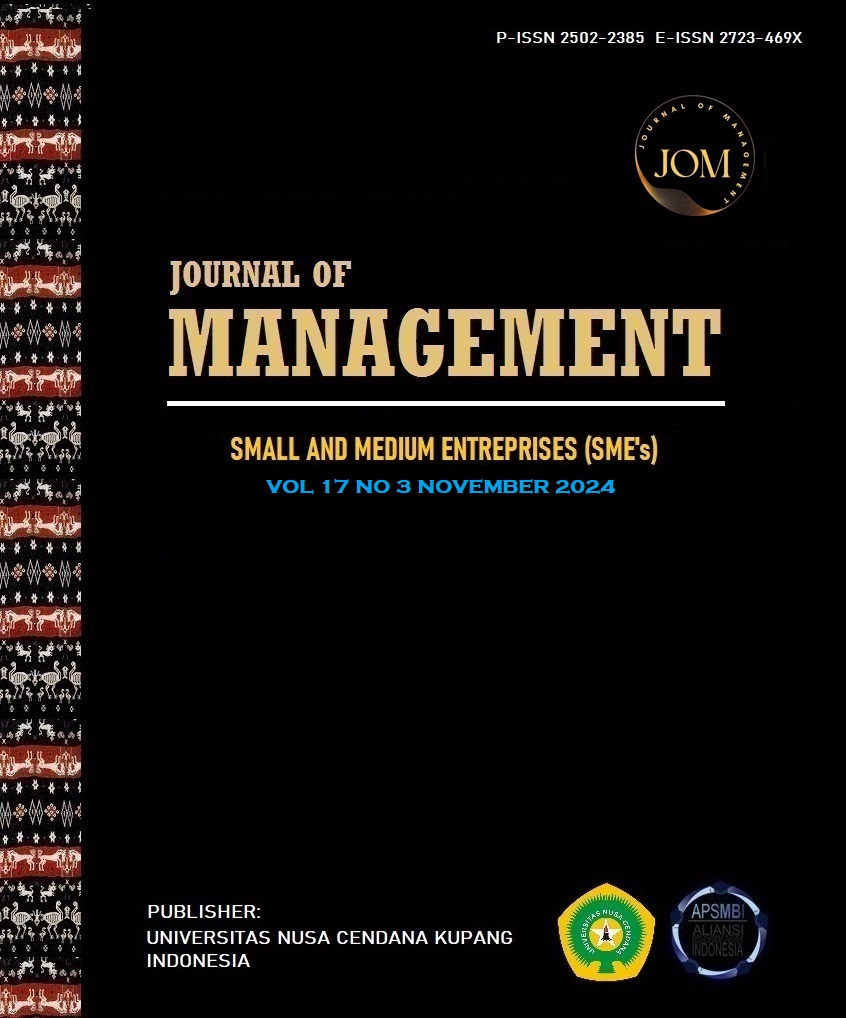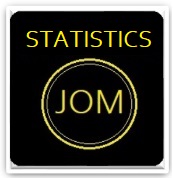ANALISIS RETURN ON ASSETS (ROA), LOAN TO DEPOSITS RATIO (LDR) DAN BEBAN OPERASIONAL PENDAPATAN OPERASIONAL (BOPO) UNTUK MENILAI KINERJA PERBANKAN PADA PT BANK RAKYAT INDONESIA (PERSERO) Tbk
Abstract
This study aims to analyze the financial performance of PT Bank Rakyat Indonesia (Persero) Tbk during the 2016-2020 period using Return on Assets (ROA), Loan to Deposit Ratio (LDR), and Operating Expenses to Operating Income (BOPO) as the main indicators. The data used is the annual financial reports of BRI, which are processed using a descriptive quantitative approach. The results show that BRI's ROA declined from 2.67% in 2016 to 1.29% in 2020, but remained above the minimum bank health threshold. The LDR fluctuated during this period, with the highest ratio at 89.5% in 2018, but it did not meet the healthy bank ratio standard. BOPO also decreased, yet it did not reach the expected efficiency level as per Bank Indonesia's standard. Overall, BRI demonstrated healthy asset productivity performance but requires operational efficiency and fund utilization improvements. This study recommends enhancing liquidity and operational efficiency to improve the bank's overall financial performance.
Keywords: Financial Performance; Return On Assets, Loan to Deposit Ratio; Beban Operasional Pendapatan Operasional
Downloads
References
https://doi.org/10.1016/j.econlet.2021.109890
Akhtar, Q., & Nosheen, S. (2022). The impact of fintech and banks M&A on Acquirer’s performance: A strategic win or loss? Borsa Istanbul Review, 22(6), 1195–1208. https://doi.org/10.1016/j.bir.2022.08.007
Al-Shari, H. A., & Lokhande, M. A. (2023). The relationship between the risks of adopting FinTech in banks and their impact on the performance. Cogent Business and Management, 10(1). https://doi.org/10.1080/23311975.2023.2174242
An, J., Hou, W., & Liu, X. (2022). Historical Determinants of Fintech Development: Evidence from Initial Coin Offerings. Finance Research Letters, 46(PB), 102472. https://doi.org/10.1016/j.frl.2021.102472
Arner, D. W., Buckley, R. P., Zetzsche, D. A., & Veidt, R. (2020). Sustainability, FinTech and Financial Inclusion.
European Business Organization Law Review, 21(1), 7–35. https://doi.org/10.1007/s40804-020-00183-y
Banna, H., Kabir Hassan, M., & Rashid, M. (2021). Fintech-based financial inclusion and bank risk-taking: Evidence from OIC countries. Journal of International Financial Markets, Institutions and Money, 75(February), 101447.
https://doi.org/10.1016/j.intfin.2021.101447
Banna, H., Mia, M. A., Nourani, M., & Yarovaya, L. (2022). Fintech-based Financial Inclusion and Risk-taking of Microfinance Institutions (MFIs): Evidence from Sub-Saharan Africa. Finance Research Letters, 45(May 2021), 102149.
https://doi.org/10.1016/j.frl.2021.102149
Benedetti, H., & Nikbakht, E. (2021). Returns and network growth of digital tokens after cross-listings. Journal of Corporate Finance, 66(January), 101853.
https://doi.org/10.1016/j.jcorpfin.2020.101853
Chinoda, T., & Mashamba, T. (2021). Fintech, financial inclusion and income inequality nexus in Africa. Cogent Economics and Finance, 9(1).
https://doi.org/10.1080/23322039.2021.1986926
Emara, N., & Zhang, Y. (2021). The non-linear impact of digitization on remittances inflow: Evidence from the BRICS. Telecommunications Policy, 45(4), 102112. https://doi.org/10.1016/j.telpol.2021.102112
Festa, G., Elbahri, S., Cuomo, M. T., Ossorio, M., & Rossi, M. (2023). FinTech ecosystem as influencer of young entrepreneurial intentions: empirical findings from Tunisia. Journal of Intellectual Capital, 24(1), 205–226. https://doi.org/10.1108/JIC-08-2021-0220
Frimpong, S. E., Agyapong, G., & Agyapong, D. (2022). Financial literacy, access to digital finance and performance of SMEs: Evidence From Central region of Ghana. Cogent Economics and Finance, 10(1). https://doi.org/10.1080/23322039.2022.2121356
Gancarczyk, M., Łasak, P., & Gancarczyk, J. (2022). The fintech transformation of banking: Governance dynamics and socio-economic outcomes in spatial contexts. Entrepreneurial Business and Economics Review, 10(3), 143–165.
https://doi.org/10.15678/EBER.2022.100309
Hamdana, Murwani, F. D., Sudarmiatin, & Hermawan, A. (2022). The effects of financial and technology literacy on the sustainability of Indonesian SMEs: Mediating role of supply chain practice. Uncertain Supply Chain Management, 10(4), 1449–1456. https://doi.org/10.5267/j.uscm.2022.6.011
Hua, X., & Huang, Y. (2021). Understanding China’s fintech sector: development, impacts and risks. European Journal of Finance, 27(4–5), 321–333.
https://doi.org/10.1080/1351847X.2020.1811131
Imerman, M. B., & Fabozzi, F. J. (2020). Cashing in on innovation: a taxonomy of FinTech. Journal of Asset Management, 21(3), 167–177. https://doi.org/10.1057/s41260-020-00163-4
Msomi, T. S., & Nzama, S. (2022). Financial literacy and SME loan repayments in South Africa during the COVID-19 era. Investment Management and Financial Innovations, 19(4), 113–121. https://doi.org/10.21511/imfi.19(4).2022.09
Najib, M., Ermawati, W. J., Fahma, F., Endri, E., & Suhartanto, D. (2021). Fintech in the small food business and its relation with open innovation. Journal of Open Innovation: Technology, Market, and Complexity, 7(1).
https://doi.org/10.3390/joitmc7010088
Neelam, & Bhattacharya, S. (2022). Financial Technology Solutions for Financial Inclusion: A review and future agenda. Australasian Accounting, Business and Finance Journal, 16(5), 170–184. https://doi.org/10.14453/aabfj.v16i5.11
Ngek, N. B. (2016). Performance implications of financial capital availability on the financial literacy - Performance nexus in South Africa. Investment Management and Financial Innovations, 13(2), 354–362. https://doi.org/10.21511/imfi.13(2-2). 2016.10
Ningrat, R. G., & Nurzaman, M. S. (2019). Developing Fintech and Islamic Finance Products in Agricultural Value Chain. Journal of Islamic Monetary Economics and Finance, 5(3), 491–516. https://doi.org/10.21098/jimf.v5i3.1077
Nkundabanyanga, S. K., Kasozi, D., Nalukenge, I., & Tauringana, V. (2014). Lending terms, financial literacy and formal credit accessibility. International Journal of Social Economics, 41(5), 342–361. https://doi.org/10.1108/IJSE-03-2013-0075
Owusu, J., Ismail, M. Bin, Osman, M. H. B. M., & Kuan, G. (2019). Financial literacy as a moderator linking financial resource availability and SME growth in Ghana. Investment Management and Financial Innovations, 16(1), 154–166. https://doi.org/10.21511/imfi.16(1).2019.12
Suryanto, S., Muhyi, H. A., Kurniati, P. S., & Mustapha, N. (2022). Banking Financial Performance in the Industry Financial Technology Era. Journal of Eastern European and Central Asian Research, 9(5), 889–900.
https://doi.org/10.15549/jeecar.v9i5.1075
Thomas, N. M. (2023). Modeling key enablers influencing FinTechs offering SME credit services: A multi-stakeholder perspective. Electronic Markets, 33(1).
https://doi.org/10.1007/s12525-023-00627-6
Yang, X., Yang, J., Hou, Y., Li, S., & Sun, S. (2023). Gamification of mobile wallet as an unconventional innovation for promoting Fintech: An fsQCA approach. Journal of Business Research, 155(PA), 113406.
https://doi.org/10.1016/j.jbusres.2022.113406

 Katarina Syukur Arniwati Gea(1*)
Katarina Syukur Arniwati Gea(1*)



